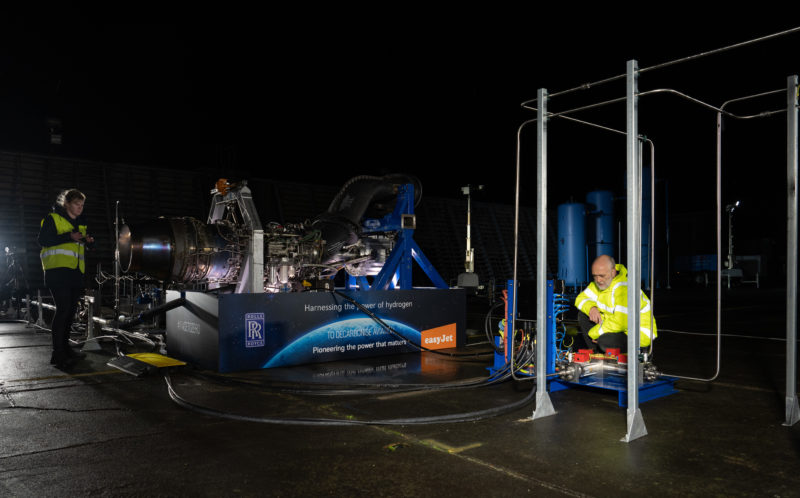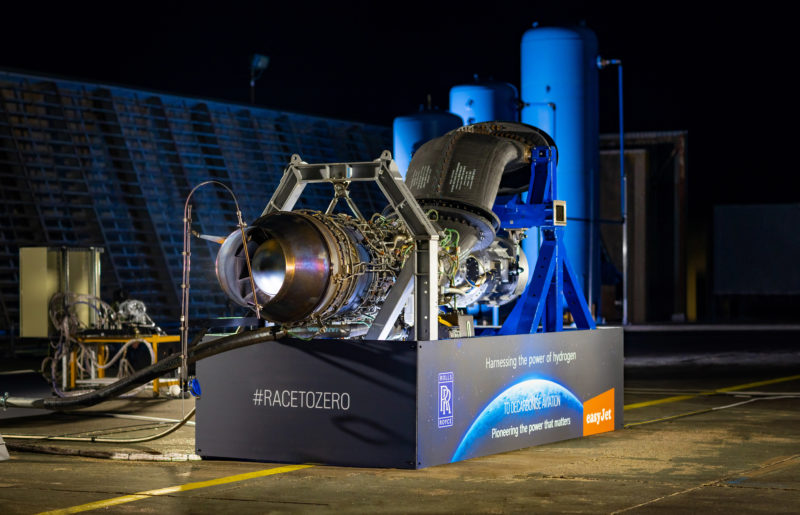Whilst the use of Jet-1A and SAF will be taking dominance over the next few years, there are other technologies that are being looked at – in this case, we are going to look at Hydrogen.
Rolls-Royce and easyJet announced they have set a new aviation milestone – with the world’s first run of a modern aero engine on hydrogen.

The test was conducted on the ground, on an early concept demonstrator using green hydrogen created by wind and tidal power. According to Rolls Royce and easyJet, it marks a major step towards proving that hydrogen could be a zero-carbon aviation fuel of the future and is a key proof point in the decarbonisation strategies of both companies
Both companies propose that hydrogen can safely and efficiently deliver power for civil aero engines and are already planning a second set of tests, with a longer-term ambition to carry out flight tests.

The test took place at an outdoor test facility at MoD Boscombe Down, UK, using a converted Rolls-Royce AE 2100-A regional aircraft engine. Green hydrogen for the tests was supplied by EMEC (European Marine Energy Centre), generated using renewable energy at their hydrogen production and tidal test facility on Eday in the Orkney Islands, UK.
The next steps include plans for a series of further rig tests leading up to a full-scale ground test of a Rolls-Royce Pearl 15 jet engine.
In Quotes
Secretary of State for Business, Energy and Industrial Strategy, Grant Shapps, said:
“The UK is leading the global shift to guilt-free flying, and today’s test by Rolls-Royce and easyJet is an exciting demonstration of how business innovation can transform the way we live our lives.
“This is a true British success story, with the hydrogen being used to power the jet engine today produced using tidal and wind energy from the Orkney Islands of Scotland – and is a prime example of how we can work together to make aviation cleaner while driving jobs across the country.”
Grazia Vittadini, Chief Technology Officer, Rolls-Royce, said:
“The success of this hydrogen test is an exciting milestone. We only announced our partnership with easyJet in July and we are already off to an incredible start with this landmark achievement. We are pushing the boundaries to discover the zero carbon possibilities of hydrogen, which could help reshape the future of flight.”
Johan Lundgren, CEO of easyJet, said:
“This is a real success for our partnership team. We are committed to continuing to support this ground-breaking research because hydrogen offers great possibilities for a range of aircraft, including easyJet-sized aircraft. That will be a huge step forward in meeting the challenge of net zero by 2050.”
A first step

As aviation (as well as other industries) seek to decarbonise, the development of new technologies, new methods and identifying solutions is a step forward – be it with electric-powered flight (using batteries or other energy storage and generation techniques), Sustainable Aviation Fuel (for some, an ideal solution with it being able to be used as a drop-in solution) and now – hydrogen.
There will be many hurdles to overcome, but sometimes, working on where to place the first piece of any jigsaw is hard – least of all in this technology.
Today is a first, public step – with many more to come as easyJet, Rolls Royce and many others will attempt to understand how hydrogen fits in the grand scheme of things, as well as its viability to operate commercially in the air.
Images, Rolls Royce
Welcome to Economy Class and Beyond. Your no-nonsense guide to network news, honest reviews, featuring in-depth coverage, unique research, as well as the humour and madness I only know how to deliver.
Follow me on Twitter at @EconomyBeyond for the latest updates, as well as Mastodon too! You can follow me on Instagram too!
Also, remember that we are part of the BoardingArea community, bringing you the latest frequent flyer news from around the world.